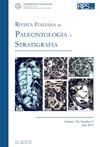OF HIS BONES ARE CRINOID MADE: TAPHONOMY AND DEADFALL ECOLOGY OF MARINE REPTILES FROM A PELAGIC SETTING (MIDDLE-UPPER JURASSIC OF NORTHEASTERN ITALY)
IF 1.6
3区 地球科学
Q2 GEOLOGY
引用次数: 0
Abstract
Modern cetaceans are considered the best anatomical and ecological analogue for many Mesozoic secondary aquatic reptiles. Such similarities extend also after the death of these phylogenetically distant amniotes, when the sinking and decomposition of large carcasses in marine environments (deadfalls) follow common biostratinomic processes. Most taphonomic studies on Mesozoic deadfalls have been limited to shallow-water settings, often neglecting deeper waters. Here we provide a detailed taphonomic survey of ichthyosaurs, pliosaurs and metriorhynchoids from the pelagic Middle-Upper Jurassic Rosso Ammonitico Veronese (RAV) of northeastern Italy. Our taphonomic revision of the RAV tetrapod record highlights a common poor state of preservation of the bones, often associated with abundant macrofossils, consistent with a prolonged exposure of carcasses on a well-oxygenated seafloor. For the first time we confirm the role of nautiloids as active mobile scavengers by means of tens of beak elements found closely associated with, or even piercing, the bones. Hexanchiform shark teeth are also found associated with the carcasses, supporting a distinctive deep-water mobile scavenging community. Echinoids, sponges and other bioeroders are identified as representative of the enrichment-opportunist stage, and a high concentration of belemnites is believed to be indicative of mass-spawning deaths in the surroundings of the carcasses. Abundant crinoids are recognized as part of the reef stage by colonization of the eroded bones. While some of our data deviate from previous Mesozoic reptile-falls from shallow-waters, they are consistent with findings at Recent whale-falls in bathyal zones, and overall represent a precious window into the complex ecology of Jurassic open seas.他的骨头是板岩做的:海洋爬行动物在大洋环境(意大利东北部中-上侏罗世)中的岩石学和死亡生态学
现代鲸目动物被认为是许多中生代次级水生爬行动物在解剖学和生态学方面的最佳类比。这种相似性还延伸到这些系统发育上遥远的羊膜动物死亡之后,大型尸体在海洋环境中的下沉和分解(死陨)遵循共同的生物地层学过程。大多数关于中生代死亡瀑布的岩石学研究仅限于浅水环境,往往忽略了深水环境。在此,我们对意大利东北部中-上侏罗世水层的鱼龙类、长鱼龙类和元鱼龙类进行了详细的岩石学调查。我们对 RAV 四足类动物记录的岩石学研究表明,骨骼的保存状况普遍较差,而且往往伴有大量的大化石,这与尸体长期暴露在氧气充足的海底是一致的。通过发现与骨骼密切相关甚至刺穿骨骼的数十个喙元素,我们首次证实了鹦鹉螺类动物是活跃的移动清道夫。此外,还发现了与尸体相关的六髻鲨牙齿,支持了一个独特的深水移动食腐群落。回声类、海绵和其他生物爬行动物被确认为富集-机会阶段的代表,而大量的贝类被认为是尸体周围大量产卵死亡的标志。大量的棘皮动物被认为是珊瑚礁阶段的一部分,因为它们在被侵蚀的骨骼上定居。虽然我们的一些数据与以往浅水区中生代爬行动物坠落点的数据不同,但它们与近代深海区鲸鱼坠落点的发现一致,总体上是了解侏罗纪开阔海域复杂生态环境的一个珍贵窗口。
本文章由计算机程序翻译,如有差异,请以英文原文为准。
求助全文
约1分钟内获得全文
求助全文
来源期刊
CiteScore
3.60
自引率
4.30%
发文量
28
审稿时长
>12 weeks
期刊介绍:
The Rivista Italiana di Paleontologia e Stratigrafia was founded in 1895. It publishes original papers dealing with all fields of paleontology and of stratigraphy, from Italy and the Mediterranean to the Tethys, as well across the globe from China to North America.

 求助内容:
求助内容: 应助结果提醒方式:
应助结果提醒方式:


